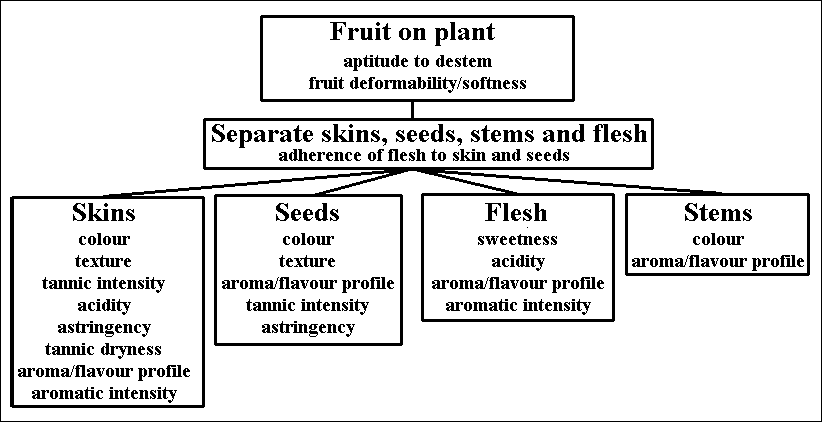






|

|

|

|

|

|


| Extract colour: | Low intensity | --> Green, some colour | --> Uniform yellow-straw or darker red/purple colour | --> Uniform ambre/black colour, high extract |
| Extract character: | Acidic and astringent | --> Less acidic and astringent | --> Low acid and astringency | --> Round, fine grained tannins |
| Maturity level: | Unripe | --> Ripe | --> Very ripe |
| Colour/physical: | Green | --> Brown | --> Brittle brown |
| Aroma/Flavour: | Leafy, vegetal | --> Resinous wood, spice (cloves, cinnamon, pepper) | --> Dried leaf, tea, herbal |
| Colour: | Lighter | --> Darker (highly dependant on variety) | |
| Physical texture: | Hard | --> Softer textured | --> Chewy |
| Aroma/Flavour: | Herbaceous | --> Neutral/slight fruitiness, slightly herbaceous | --> Intense fruit, no herbaceousness |
| Tannic intensity: | Higher | (rapid increase followed by decrease after véraison) | --> Lower |
| Acidity: | Higher | --> Lower | |
| Astringency: | Lower | --> Higher |
| Colour: | Green | --> Green-yellow | --> Maroon | --> Chestnut, no green | --> Dark/tan brown |
| Texture: | Pliable, brittle, "wet" | --> Woody, less brittle, "dry" | |||
| Seed integrity: | Seed strongly in tact with flesh | --> Seed has lost most adherence to flesh | |||
| Taste: | Dry, astringent, bitter, harsh | --> Less dry, astringent, bitter, harsh | |||
| Aromas/Flavour: | Grassy/herbaceous | --> Toasted | --> Almost roasted |
| Tannic intensity: | Rapid increase followed by slow but small decrease over the entire maturing period |

| Fruit flesh: | Hard, firm adherence to seeds and skin | --> Softer, less adherence to seeds and skin |
| Fruit deformability: | Low | --> High |
| Aptitude to destem: | Low | --> High |


 |  |
| Figure 6. Dissection of a gooseberry showing skin (left) and flesh (right) | Figure 7. Dissection of a gooseberry showing seeds (left) and half of the whole fruit (right) |
